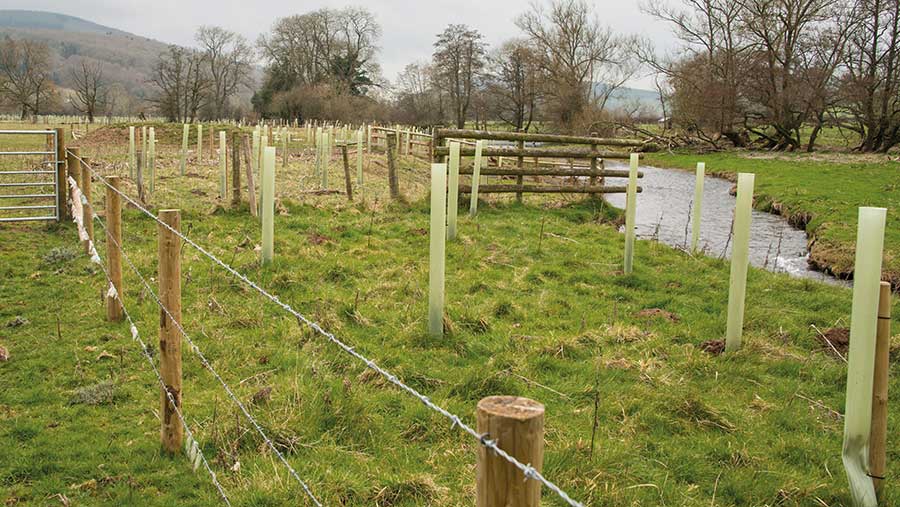How to establish and manage newly planted trees
 © Woodland Trust/Phil Formby
© Woodland Trust/Phil Formby Like any crop, there can be establishment problems with trees, as well as unexpected challenges.
Some of the most common issues are tackled below.
Guard from grazing
Grazing by animals such as deer and rabbits can be extremely damaging to new woodlands, either stunting growth or killing trees completely where the bark is stripped off.
Where such pests are a problem, polypropylene tree guards, secured against stakes, are still the main way of protecting young trees, although the type and size of guard varies depending on the main threats in that area.
In most cases, 1.2m tubes will suffice, although in areas with high populations of fallow deer, taller 1.5m tubes may be needed, while 1.8m tubes are recommended if red deer are present.
See also: Carbon credits explained long term income option for farmers
PVC spiral guards prevent rabbits and other small animals damaging the bark around the base of trees, however they will not prevent damage by deer, even small species such as muntjac, which are notorious browsers.
Check guards regularly and ensure they are pushed down to the ground.
After five to 10 years, guards are likely to have done their job and should be removed before they split, disintegrate, or restrict growth.
For some large planting projects, it may be cost-effective to fence the entire area, although the type and size of fencing has to be tailored to the main threats in that location.
Research is ongoing to find alternatives to plastic tree guards. One option is looking at using “sacrificial planting”, whereby trees are planted at a higher density in the knowledge that some will be lost to animal browsing, but enough will survive to produce a woodland.
Another option is to plant thorny species around the outside of new woodlands to deter animals from entering.
Where natural materials are available (for example, brush wood from coppicing), there may be scope to erect natural barriers around smaller planted areas.
Weed control
In the first two years of establishing a new woodland, effective weed control is essential if the surrounding vegetation is having an impact on tree establishment.
Keep an area of 1m diameter around every tree clear of grass and weeds, using either a thick mulch (minimum 10cm of bark or straw), laying a weed-suppressing membrane, or spot spraying with glyphosate, only if absolutely necessary.
Just strimming or mowing around trees is less effective, as grasses and weeds will still be competing with saplings.
Remember to pull out any weeds growing up inside tree guards, too.
Watering
Trees must adapt to the local conditions, so generally it is best not to water saplings regularly, unless a period of drought is experienced before roots are established.
In this case, it is best to thoroughly soak the soil around each tree to ensure it percolates into the profile, drawing roots down with it.
Applying small amounts to the surface draws roots up, which then means they struggle to find water as soon as the surface dries out.
In prolonged droughts, it may be necessary to repeat watering after a few weeks.
Gapping-up/thinning
Some planting losses are almost inevitable, although anything more than 20% indicates a particular problem(s) at that site and should be investigated further.
The best time to check establishment is in the second summer after planting, with a view to returning that winter to plant replacements.
Leaving it longer means replacement saplings will be going in alongside larger, older trees and may struggle to compete.
Longer-term (more than 10 years), thinning may be necessary once trees get to about 7m tall.
Removing selected trees gives remaining trees more space to grow stronger and more resilient.
Similarly, coppicing encourages new, denser growth and lets light reach the woodland floor.
Note that a felling licence may be needed for trees with a diameter of less than 10cm at chest height.
Thanks to Woodland Trust, whose sponsorship made it possible for us to run this article. Farmers Weekly had full editorial control of its content.
Woodland Trust MOREwoods scheme

Trees should be in every farmer’s toolbox. They boost productivity, resilience and the health of the environment – with no need to trade off with production. Make your planting project a success with the Woodland Trust’s MOREwoods scheme, funded by Lloyds Bank.
Plant at least 0.5ha and we could cover up to 75% of costs. An expert will visit to discuss the best options for your business and if eligible, arrange tree delivery and protection.
All trees are sourced and grown in the UK and Ireland. No obligation advice is available even if you decide not to plant.
